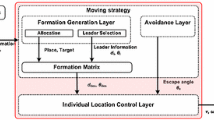Abstract
This paper proposes a formation controller for multi-agent systems focusing on the obstacle avoidance and input constraints. In our proposed method, the limitation of translation and angular velocities is adaptably tuned depending on the existence of obstacles, such that the velocities can increase when the robots potentially hit obstacles. Moreover, a potential function of the input velocities that easily satisfies velocity constraints is designed. We also design a formation controller that realizes obstacle avoidance while satisfying the velocity constraints. Mathematical analysis shows the stability of the formation of robots controlled by the proposed model. Simulation results also demonstrate the effectiveness of the proposed method.






Similar content being viewed by others
References
Dong W, Ghalia MB, Farrell JA (2011) Distributed control of multiple wheeled mobile robots. 50th IEEE conference on decision and control and European control conference Orlando, FL, USA
Wang Q, Fang H, Chen J, Mao Y, Dou L (2012) Flocking with obstacle avoidance and connectivity maintenance in multi-agent systems. 51st IEEE conference on decision and control Hawaii, USA
Olfati Saber R (2006) Flocking for multi-agent dynamic systems: algorithms and theory. IEEE Trans Autom Control 51(3):401–420
Chen X, Jia Y, Du J, Yu F (2011) Column formation control of multi-robot systems with input constraints. 50th IEEE conference on decision and control and European control conference Orlando, FL, USA
Mastellone S, Stipanovi\(\acute{c}\) DM, Spong MW (2007) Remote formation control and collision avoidance for multi-agent nonholonomic systems. 2007 IEEE international conference on robotics and automation Roma, Italy
Furuta K (1963) Linear systems control theory, Shokodo. (In Japanese)
Martin JC, George L (1981) Continuous state feedback guaranteeing uniform ultimate boundedness for uncertain dynamic systems. IEEE Trans Autom Control 26(5):1139–1144
Author information
Authors and Affiliations
Corresponding author
Appendix
Appendix
Here, we derive a necessary condition to satisfy “Approximated constraint”. The feedback parameters with constraint \(\lambda _j\) are
If either the value inside the square root of Eq. (28) or that of Eq. (29) is negative, these parameters become complex and thus the control input cannot be calculated. Therefore, the control input is determined only when
Because \(v_i=k_{i_{1}}(t)x_{i-1,i} +v_{i-1}\cos \beta _{i-1,i} +g_i\), the necessary condition becomes
This condition represents the relationship between parameters of robot \(R_i\) (leader robot) and those of \(R_j\) (follower robot). Eq. (31) requires comparatively larger \(\lambda _j\) than \(\lambda _i\).
About this article
Cite this article
Niizuma, N., Nakano, K., Funato, T. et al. Group motion control of multi-agent systems with obstacle avoidance: column formation under input constraints. Artif Life Robotics 20, 70–77 (2015). https://doi.org/10.1007/s10015-015-0197-x
Received:
Accepted:
Published:
Issue Date:
DOI: https://doi.org/10.1007/s10015-015-0197-x





